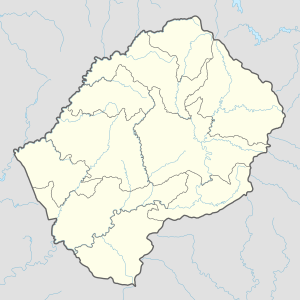This article needs additional citations for verification. (July 2009) |
Moyeni, Quthing | |
|---|---|
Town | |
| Coordinates: 30°24′00.4″S 27°42′00.7″E / 30.400111°S 27.700194°E | |
| Country | |
| District | Quthing District |
| Elevation | 1,500 m (4,921 ft) |
| Population (2016) | |
• Total | 27,314 |
| Time zone | UTC+2 (SAST) |
Quthing, also known as Moyeni (Sesotho for "place of wind"), is a constituency and the capital city or camptown of Quthing District in Lesotho. Quthing was established in 1877, abandoned in the Gun War of 1880, and then rebuilt at its present site – the southernmost town in Lesotho.[2][3] It has a population of 27,314 (2016 census).
Moyeni is divided into Lower Moyeni and Upper Moyeni. Lower Moyeni is largely used for commercial and residential purposes. Upper Moyeni is mainly for administrative purposes and residences for government officials.[4]
Quthing district is home to a diverse group of people who speak different languages. King Moorosi, the leader of the Baphuthi people, who occupied the Quthing District in southeastern Basutoland (today's Lesotho) in the 1800s, died on Mount Moorosi in 1879 in a war against the Cape Colony.
Rock and cave art are to be found near Quthing, which were created by the San people who settled in this area. Quthing lies in the southern part of Lesotho and borders the Eastern Cape province of South Africa. The Senqu River flows through the district of Quthing as it makes its long journey to the Atlantic Ocean. The border post between Lesotho and South Africa is called Tele Bridge.
During King Moshoeshoe's reign he allocated this part of the country mostly to the Baphuthi people led by King Moorosi.
- ^ GTOPO30 via GeoNames. Retrieved 2010-06-24.
- ^ Lesotho Embassy in Rome Archived 2011-07-13 at the Wayback Machine
- ^ "Moyeni". Lesotho-info.co.za. Retrieved 19 November 2022.
- ^ "Moyeni Camp, Quthing, Lesotho: Maps". Maphill.com. Retrieved 1 February 2019.
